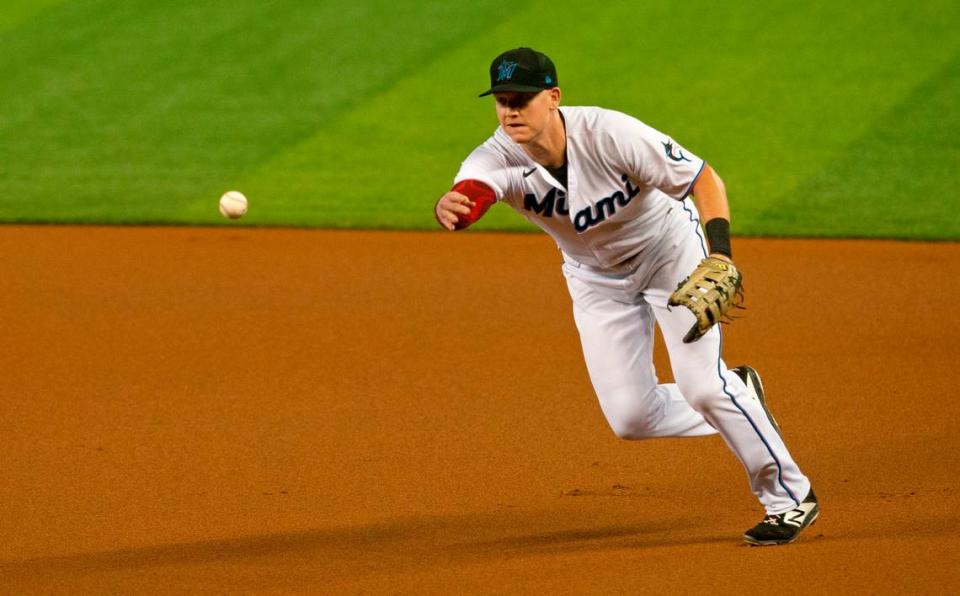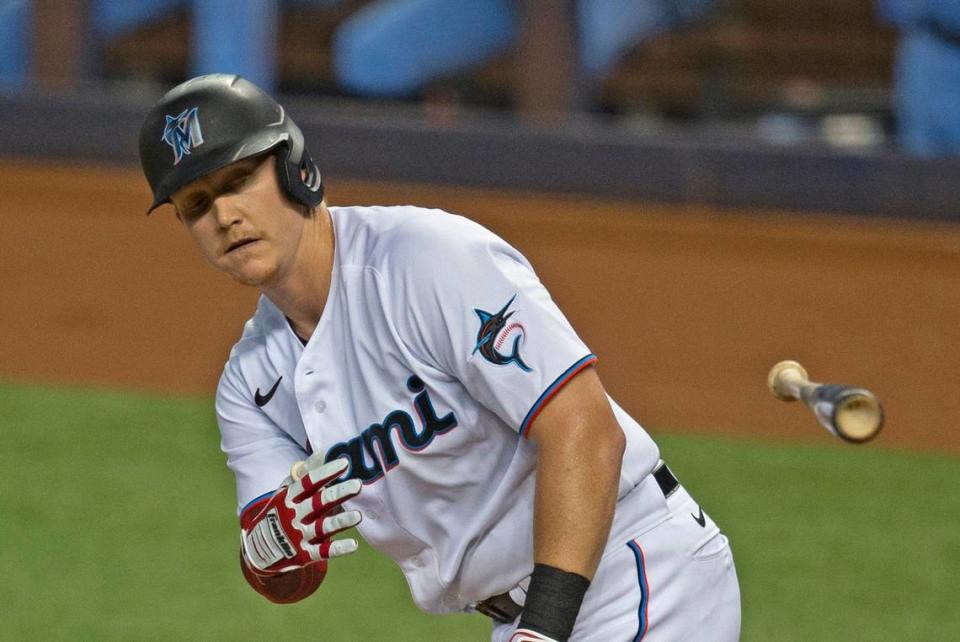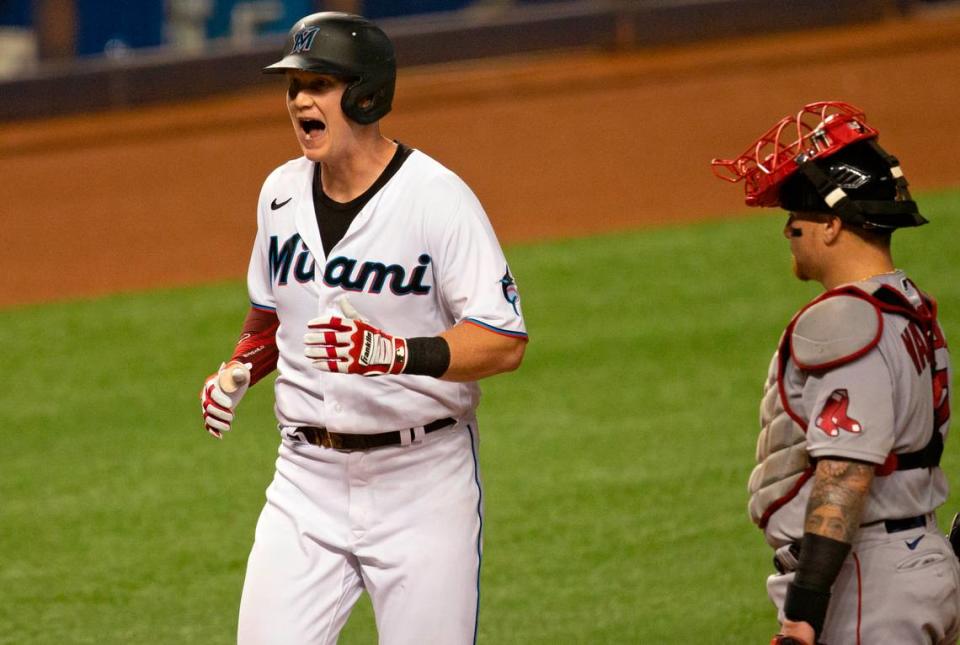After signs of growth in 2020, Marlins’ Cooper now adapts to new path for playing time
- Oops!Something went wrong.Please try again later.
The conversation came shortly before spring training began.
Marlins general manager Kim Ng and manager Don Mattingly sat down with Garrett Cooper virtually via Zoom and explained the path moving forward.
At the time of the conversation — and as of the time of this writing — the National League is not expected to have a designated hitter this season. Jesus Aguilar is expected to get the bulk of the reps at first base. The team also signed Adam Duvall to be their primary right fielder, Cooper’s secondary position, albeit one he hasn’t played in almost two years.
So where does that leave Cooper in the Marlins’ plans?
As of right now, the Marlins slugger will bounce between first base and right field, spelling Aguilar and Duvall to make sure all three stay fresh. In a full 162-game season, there’s a path for all three to get 100-plus starts.
“I think this is a great way and it gives Donnie a lot of options and different scenarios to keep our guys fresh,” Ng said last week. “I think that’s one thing that we’ve got going for us. We’re going to have a pretty nice lineup as well when we head into those American League cities.”
Cooper has accepted the fact that this is his path to playing time this season and is taking advantage of the opportunity to show once again that he can be a reliable threat in the lineup.
“Last year, I gave them a taste of what I can do when healthy,” said Cooper, who had career-best marks in on-base percentage (.353), slugging (.500) and OPS (.853) in 34 games during the shortened 2020 season. He missed 24 games early in the season after testing positive for COVID-19 “... But you’ve got to make adjustments. You can’t just rely on what you did the game before or the week before. Every at-bat is your job. There are young guys coming for your job and people around the league coming for your job. I take it personally.”
Now, Cooper has no ill will toward Aguilar or Duvall. He called Aguilar “a big, fun-loving guy who keeps the energy up that was a big addition last year” and embraces the competition for playing time, especially knowing the value all three bring to the club despite there being just two starting spots for them on a daily basis.
“You don’t get to the big leagues by just getting a position and thinking you’re going to stay there,” Cooper said. “I think everybody comes into spring wanting to get a job. It’s been no different for me.”

Changing his routine
Cooper has played just 40 career games in the outfield, 31 of which came during the 2019 season and the other nine during his limited action in 2018.
After playing exclusively at first base and designated hitter a year ago, Cooper knew he had to change up his usual offseason routine in an effort to be prepared to play multiple positions.
So back home in California, he focused more on cardio and yoga and less on weights. He visited with the Los Angeles Lakers’ podiatrist, Howard Liebeskind, upon the recommendation of friends in the NBA, MLB and NHL to get advice on how to be more agile and mobile.
“I really wanted to see what an offseason looks like for NBA players and all these guys,” Cooper said, “how they continue to build their lower-body strength because they’re running all the time.”
The goal: Be as nimble and flexible as possible.
And, of course, stay on the field. Cooper dealt with a calf strain and a hamstring injury the last time he played in the outfield in 2019. He missed 25 games early in the season due to the calf strain and the final 15 games of the year because of the hamstring injury.
How does he feel heading into 2020?
“The best I’ve felt since my early 20s leg wise,” the 30-year-old Cooper said, “so I think the changes that I did this offseason hopefully continue to show as I move between first base and outfield.”

Garrett Cooper the slugger
But while his alternating positions in the field is the story line, it’s Cooper’s bat that will keep him in the lineup.
Cooper’s a career .281 hitter with 21 home runs, 78 RBI and 77 runs scored. Of his 162 career hits, 53 — 32.7 percent — have gone for extra basis. His .460 slugging mark during the past two seasons ranks second on the Marlins only to third baseman Brian Anderson (.467). His .353 batting average on balls in play since 2019 trails just catcher Jorge Alfaro (.359) and super utility player Jon Berti (.358).
During the shortened 2020 season, Cooper ranked in the 95th percentile in the league for expected batting average (.304), the 87th percentile for expected slugging (.521) and the 71st percentile for exit velocity (90.1). He had a career-low 22.2 percent swing-and-miss rate over his 133 plate appearances, bettering the 23.4 percent mark he had in 2019. Both of those are better than league average (24.5 percent).
He also has a knack for hitting line drives (33.7 percent in 2020 and 29.2 percent for his career, both above the MLB average of 25.7 percent) and rarely pops balls up (3.1 percent, four percentage points lower than the MLB average of 7.1). He also hits to all fields (31.6 percent pull, 37.9 percent straight, 30.4 percent opposite field for his career).
Cooper credits a few mechanical adjustments — namely sitting on his back hip which allowed him to better control his swing — for his improvement at the plate in 2020.
He points specifically to his two-run home run against the Atlanta Braves’ Kyle Wright on Sept. 8 — a 414-foot line drive to left field on a 1-0 fastball low and inside —as the most fitting example of this. The exit velocity on that home run? 109.3 mph.
“I realized there’s a lot more space for me as a hitter sitting on my back hip than I realized,” Cooper said. “... Last year was really eye-opening probably to people in this organization, people around MLB how hard I hit the ball. You can go online and read all those analytics things that everyone talks about now, but I just felt like there were a lot of pitches I hit last year down and in, up and in. The exit velos were a lot harder. That was the progression I made. ”

Commitment from the Marlins
Cooper is also quick to acknowledge the Marlins’ commitment to him this offseason. With the continued uncertainty about a universal designated hitter this season and both Cooper and Aguilar arbitration-eligible, the Marlins easily could have attempted to trade one of the two.
Instead, they doubled down and offered both one-year deals to avoid arbitration. Aguilar, in his last year before free agency, will make $4.35 million in 2021 with a chance to make an additional $150,000 for hitting certain plate appearance benchmarks. Cooper, who was in his first of three arbitration-eligible offseasons, will make $1.8 million this season, a number that could increase to $2.05 million with performance bonuses.
“As you’re around this organization more, you see the changes that are being made and you see these young guys and you want to be here,” said Cooper, who was part of the first trade made by the Bruce Sherman/Derek Jeter ownership group — one that brought in Cooper and Caleb Smith from the New York Yankees in exchange for pitching prospect Michael King. “It was a good offseason. I let the agent handle all that. We got to a deal and then it was back to business. .... It showed the Marlins wanted to get the deal done and showed me that they want me be here.”
Cooper now hopes to show them the next level of his game. Cooper said he merely views 2020 as a “good stepping stone” for what he can offer. He knows there’s more in the tank and hopes to show it over a full season — regardless of where he plays in the field.
“People have different terms of what a good hitter is,” Cooper said. “To me, a .280-.290 hitter with 25 to 35 homers is a very useful player and that’s a very attractive player to a lot of front office and analytic guys.”

